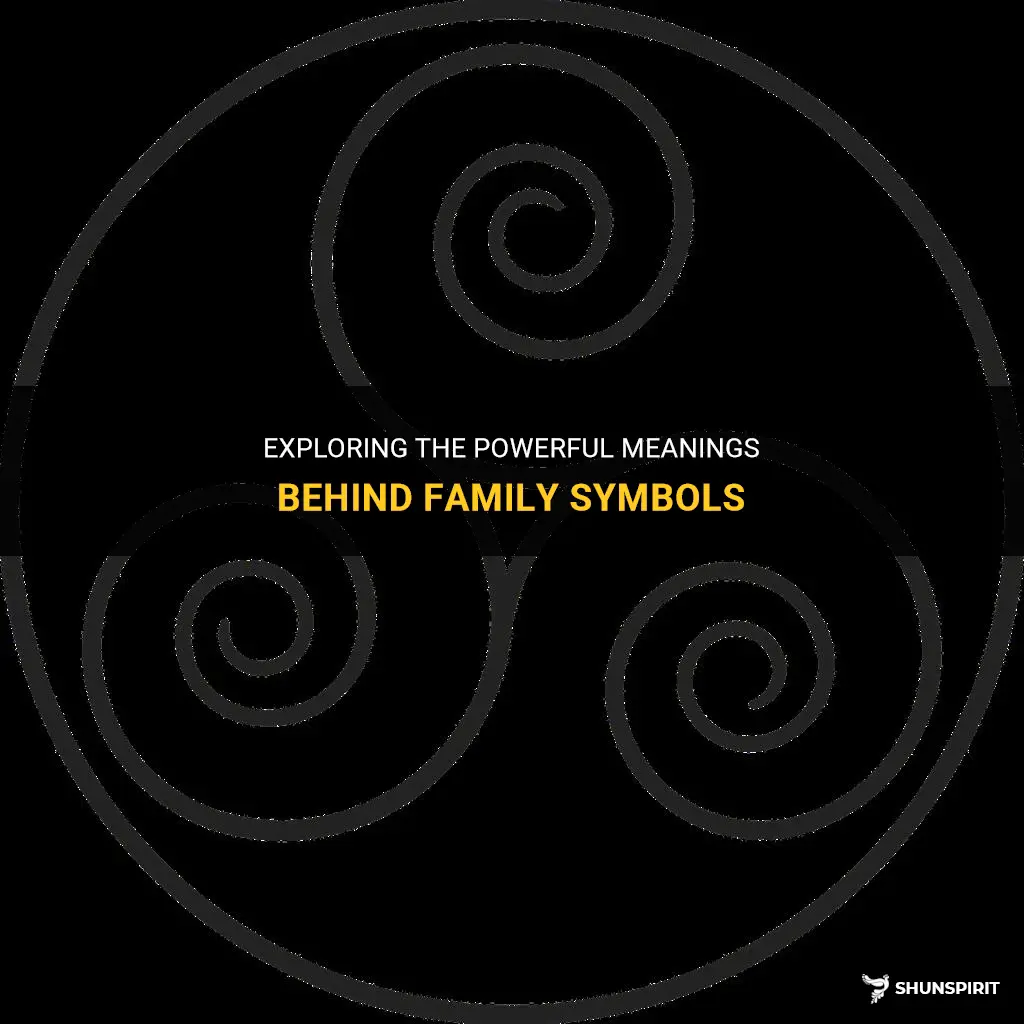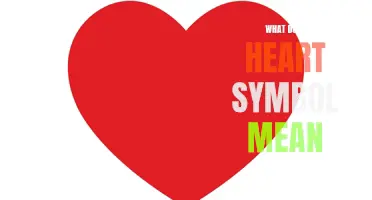
Family symbols and their meanings hold a special place in our hearts. They are not just mere objects or images, but powerful reminders of our familial bonds, values, and traditions. These symbols can range from simple objects like photos or heirlooms to more abstract concepts like a family crest or coat of arms. Each symbol bears its own significance, telling stories of lineage, heritage, and unity. As we delve into the world of family symbols, we unravel the threads that connect us to our past, present, and future, shaping our sense of identity and belonging. Join me on this exploration as we discover the beauty and depth behind these treasured emblems of family.
What You'll Learn
- What are some common symbols associated with family and their meanings?
- How do family symbols differ across different cultures and societies?
- Can symbols and meanings associated with family evolve or change over time?
- How do family symbols and meanings contribute to a sense of identity and belonging?
- Are there any universal symbols or meanings that can be attributed to family across different cultures?

What are some common symbols associated with family and their meanings?
Family is a fundamental part of our lives, and throughout history, various symbols have been used to represent the concept of family and its values. These symbols carry deep meanings and sentiments, representing the importance and love associated with family bonds. Here are some common symbols associated with family and their meanings:
- Tree of Life: The tree of life is a powerful symbol representing the interconnectedness of all living things. In the context of family, the tree of life symbolizes the strong roots and branches that connect family members together, signifying their support, nourishment, and growth. It represents the generations that came before and the ones that will come after.
- Knots: Knots have long been used to symbolize unity and unbreakable bonds. In many cultures, the infinity knot or the Celtic knot is associated with family, representing the everlasting love and connections within a family. It signifies the interwoven nature of family relationships and the unbreakable bond that holds them together.
- Heart: The heart symbol has been used since ancient times to express love, affection, and emotions. In the context of family, the heart symbolizes the deep love and emotional connection shared between family members. It serves as a reminder of the love, care, and support that family provides.
- Circle: The circle is a powerful symbol of unity and wholeness. In the context of family, the circle represents the unbroken bond and the endless cycle of love and support that family members provide to one another. It symbolizes the eternal nature of family and the continuous flow of love and connection throughout generations.
- Birds: Birds are often used as symbols of family, representing love, freedom, and protection. Just like birds care for their young and work together to build nests, families provide a safe and nurturing environment for their members. Birds also symbolize the freedom to explore and spread their wings while always having the support and protection of their family.
- Fleur-de-lis: The fleur-de-lis, a stylized lily, has been used as a symbol of royalty and nobility. In the context of family, it symbolizes the integrity, strength, and honor associated with familial bonds. It represents the idea of family members standing tall and supporting one another with dignity and grace.
- Lighthouse: Lighthouses have long been used as symbols of guidance and protection. In the context of family, the lighthouse represents the role of family members in providing support, guidance, and protection to one another. It signifies the importance of being a guiding light and a source of strength for family members during difficult times.
These symbols serve as reminders of the love, unity, and support that family provides. They carry deep meanings and sentiments, reminding us of the importance of cherishing and nurturing our family bonds. Each symbol represents a different aspect of family, but they all convey the same message of love, unity, and strength that comes with being a part of a family.
The Symbolic Meaning of the Mockingbird: Representing Innocence and Empathy
You may want to see also

How do family symbols differ across different cultures and societies?
Symbols play a significant role in every culture and society, representing beliefs, values, and traditions. They serve as a visual language, conveying a specific message or meaning that is easily recognizable by members of the community. Among the various types of symbols, family symbols hold a special place as they reflect the importance of familial bonds and relationships. However, family symbols differ across different cultures and societies, emphasizing the unique aspects of each group.
One of the major differences in family symbols is the perception of the nuclear family versus the extended family. In Western cultures, such as those in North America and Europe, the nuclear family, consisting of parents and their children, is often considered the primary family unit. Therefore, symbols representing the nuclear family, such as a silhouette of a mother, father, and child, are commonly used.
On the other hand, in many Asian cultures, the extended family holds greater importance. The extended family includes not only parents and children but also grandparents, aunts, uncles, and cousins. Therefore, family symbols in these cultures often depict not just the nuclear family but the entire extended family unit, showcasing the strong bonds and interdependence between relatives.
Another difference in family symbols arises when considering gender roles within the family. In patriarchal societies, family symbols may emphasize the importance of the male figure as the head of the family. For example, symbols might show a dominant male figure surrounded by the rest of the family members. This reflects the traditional gender roles where the father is considered the primary decision-maker and provider for the family.
In contrast, matriarchal societies may have family symbols that emphasize the significance of the female figure within the family. Symbols might depict a strong and nurturing mother figure, highlighting her role as the caregiver and emotional support system for the family. These symbols represent the unique dynamics and values within these societies.
The cultural and religious beliefs surrounding family also influence the symbolism associated with it. For instance, in some cultures, family symbols may incorporate religious symbols, such as a cross or religious scripture, to convey the importance of spirituality within the family unit. Additionally, symbols associated with specific cultural practices or rituals may be incorporated into family symbols to reflect the cultural heritage of the group.
In conclusion, family symbols vary greatly across different cultures and societies. These symbols reflect the unique aspects of each culture, including the perception of the nuclear versus extended family, gender roles, and the influence of cultural and religious beliefs. By studying and understanding these symbols, we can gain insight into the values and traditions held dear by various communities. Family symbols serve as a visual representation of the importance of family bonds and relationships, communicating a powerful message about the shared experiences and values within each culture.
Unlocking the Hidden Meanings Behind the NEDA Symbol Tattoo
You may want to see also

Can symbols and meanings associated with family evolve or change over time?
Symbols and meanings associated with family have been an integral part of human culture for centuries. However, these symbols and meanings are not static and can evolve and change over time. This evolution is influenced by various factors including societal changes, cultural shifts, and personal experiences.
One prime example of how symbols and meanings associated with family have changed over time is the concept of marriage. In many traditional cultures, marriage was seen as a union between a man and a woman for the purpose of procreation and maintaining family lineage. However, in recent years, the definition of marriage has expanded to include same-sex couples. This shift in meaning reflects the evolving understanding of family structures and the recognition of love and commitment beyond traditional gender roles.
Similarly, the symbolism of the nuclear family has also evolved. The nuclear family, consisting of a married couple and their children, was once seen as the ideal and most stable family structure. However, as divorce rates increased and single-parent households became more common, the concept of family expanded to include non-traditional structures. Blended families, single-parent families, and cohabiting couples are now recognized as valid family units, challenging the once rigid definition of the nuclear family.
Symbols associated with family have also evolved over time. The traditional symbol of a family was often depicted as a man, woman, and children standing in a neat row. However, contemporary symbols of family are more inclusive and diverse. Illustrations and drawings now include same-sex couples, adoptive families, and grandparents raising their grandchildren. These new symbols reflect the changing dynamics and demographics of modern families and promote inclusivity and acceptance.
Furthermore, the meaning of family has shifted from a biological connection to a more emotional and supportive bond. Family is no longer solely defined by blood ties but can also be chosen and created through close friendships and community connections. This expansion of the definition of family highlights the importance of emotional support and belonging, transcending the traditional notion of family being solely based on genetics.
It is important to acknowledge that symbols and meanings associated with family will continue to evolve and change as society progresses. With advancements in technology, such as assisted reproductive techniques and non-traditional forms of parenting, new family structures and meanings will continue to emerge. These changes reflect the diverse and evolving nature of human relationships and the need to adapt our understanding of family to be more inclusive and accepting.
In conclusion, symbols and meanings associated with family are constantly evolving and changing over time. The expansion of marriage to include same-sex couples, the redefinition of family structures, the inclusion of diverse family symbols, and the shift from biological to emotional connections are all examples of how family meanings and symbols have transformed. It is essential to embrace these changes and continue to foster an inclusive and accepting environment for all types of families, recognizing that love, support, and shared experiences are at the core of what it means to be a family.
Deciphering the Symbol Meanings on Your Equate Blood Pressure Monitor
You may want to see also

How do family symbols and meanings contribute to a sense of identity and belonging?
Family symbols and their meanings have long been recognized as important contributors to an individual's sense of identity and belonging. These symbols can take on many forms, from heirlooms and traditions to tattoos and personal items. They serve as reminders of one's family history, values, and connections, deepening the bond with loved ones and reinforcing a sense of identity.
One way family symbols and meanings contribute to a sense of identity is by providing a link to the past. Family heirlooms, such as jewelry or photographs, convey a sense of history and tradition, reminding individuals of the people who came before them and the experiences they shared. These heirlooms often hold sentimental value and are passed down through generations, creating a sense of continuity and connection to one's roots. For example, a grandmother's wedding ring can serve as a symbol of love and commitment that has transcended time, reminding the wearer of the enduring bonds within their family.
Furthermore, family symbols also convey the values and beliefs that are passed down from generation to generation. Religious symbols, like a cross or a Star of David, can represent the faith that has been practiced in the family for years. These symbols serve as a reminder of the values and principles that have shaped the family's identity and provide a sense of belonging within a larger community. For instance, seeing a family member pray with a religious symbol can instill a sense of unity and purpose in a person's own beliefs and practices.
In addition to physical symbols, certain rituals and traditions also contribute to a sense of identity and belonging. These can include celebrating holidays with specific customs or partaking in family traditions like Sunday dinners or annual reunions. These rituals provide a sense of structure and predictability, allowing individuals to experience a shared sense of identity and belonging. The repetition of these activities reinforces the importance of family bonds and creates a sense of comfort and familiarity.
Family symbols and their meanings can also be expressed through personal items or artwork. For example, a tattoo of a family crest or a meaningful phrase can be a permanent symbol of one's connection to their family. These personal symbols carry deep personal significance and serve as a constant reminder of one's roots, even when physically away from loved ones. Additionally, artwork created by family members, such as paintings or pottery, can serve as tangible representations of family connections and talents.
In conclusion, family symbols and their meanings play a significant role in shaping an individual's sense of identity and belonging. They provide a link to the past, convey values and beliefs, and create a sense of unity through rituals and traditions. Whether in the form of heirlooms, religious symbols, personal items, or artwork, these symbols serve as constant reminders of the bonds and connections within a family. By embracing these symbols, individuals can find a deeper sense of identity and a greater sense of belonging within their family and community.
The Fascinating Meaning Behind the Ollin Aztec Symbol
You may want to see also

Are there any universal symbols or meanings that can be attributed to family across different cultures?
Family is a universal concept that exists in every culture around the world. While the specific customs and traditions surrounding family may vary from culture to culture, there are certain symbols and meanings that can be attributed to family across different cultures.
One universal symbol of family is the idea of unity and togetherness. In many cultures, the image of a circle or a knot is used to symbolize the bond between family members. The circle represents the idea of wholeness and completeness, while the knot represents the strength and resilience of the family unit. This symbol can be found in various forms of artwork, jewelry, and even tattoos across different cultures.
Another common symbol associated with family is the tree. Across cultures, the tree is often used to represent the interconnectedness of family members and the roots that hold them together. The branches of the tree symbolize the different generations of the family, while the leaves represent individual family members. This symbol can be seen in the form of family trees, where each branch represents a different lineage or generation.
In many cultures, the home is also considered a powerful symbol of family. The physical space where a family resides is often seen as a place of safety, love, and belonging. The home is where family members come together to create memories, share meals, and support one another. In many cultures, the idea of home extends beyond the physical structure and encompasses the emotional and spiritual aspects of family life.
While the symbols and meanings associated with family may vary from culture to culture, the underlying values and emotions remain consistent. Across different cultures, family is seen as a source of love, support, and connection. Family is the place where individuals find unconditional love, acceptance, and belonging. It is a source of strength and resilience in times of hardship and a source of joy and celebration in times of happiness.
Family is a deeply ingrained aspect of human existence, and its significance is recognized and celebrated across different cultures. Through the use of universal symbols and meanings, the concept of family is able to transcend cultural boundaries and serve as a reminder of the values that we all hold dear. Whether it is a circle, a tree, or the image of a home, these symbols serve as a powerful reminder of the importance of family in our lives.
In conclusion, while the specific customs and traditions surrounding family may vary from culture to culture, there are certain symbols and meanings that can be attributed to family across different cultures. The symbols of unity, the tree, and the home are just a few examples of the universal symbols that represent the values and emotions associated with family. These symbols serve as a reminder of the importance of family in our lives and the role it plays in shaping who we are. No matter the culture or background, family is a cherished and vital part of the human experience.
The Symbolic Meaning of the White Stone: Unveiling Divine Secrets and Spiritual Transcendence
You may want to see also
Frequently asked questions
The tree symbol is often used to represent the strength and longevity of a family. It can represent the roots of the family, symbolizing deep connections and heritage. The branches of the tree can represent the different family members, growing and branching out as the family expands and continues to thrive.
The heart symbol is commonly used to represent love and affection within a family. It embodies the deep emotional bonds that exist between family members. The heart can also symbolize unity and the notion that family is at the core of one's life.
Flowers are often used to symbolize growth, beauty, and the cycle of life within a family. Just as flowers bloom and flourish, families go through different stages of growth and change. Each flower can represent a different family member, with their own unique beauty and contribution to the family unit.
The infinity symbol represents the everlasting nature of family bonds. It signifies that the love and connection within a family is infinite and will endure throughout time. The infinity symbol can also represent the idea of eternity, reinforcing the idea that family is a lifelong commitment.







